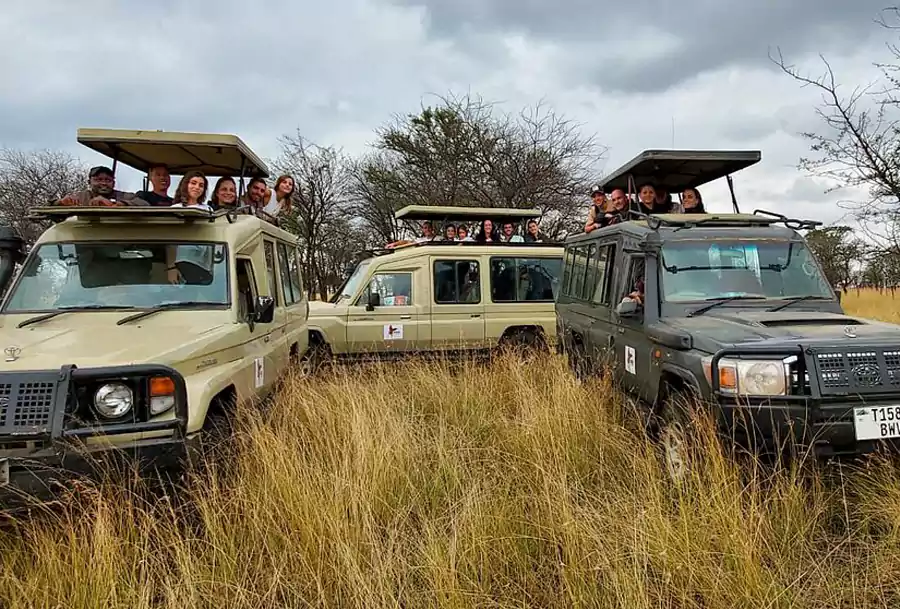No products in the cart.
Masai Mara vs. Serengeti: Choosing the Perfect Safari Adventure for You
Welcome to the most epic safari showdown of all time! Masai Mara and Serengeti, two of Africa’s most renowned wildlife havens, are set to go head-to-head in a battle for safari supremacy. Today, we’ll delve into the heart of these extraordinary destinations, uncovering their hidden gems, majestic wildlife, and the unparalleled thrill of a true safari adventure.
The Masai Mara: A Kingdom of Wildlife
Nestled in the southwestern corner of Kenya, the Masai Mara is a realm where the African savanna reigns supreme. Rolling grasslands stretch as far as the eye can see, dotted with acacia trees that provide shade for the park’s diverse inhabitants. Lions, elephants, leopards, zebras, and giraffes roam freely, while vast herds of wildebeest thunder across the plains during the Great Migration.
The Serengeti: A Realm of Wide-Open Spaces
Across the border in Tanzania lies the Serengeti, a vast expanse of savanna that stretches as far as the horizon. Renowned for its endless plains and iconic kopjes, the Serengeti is home to an abundance of wildlife, including lions, elephants, cheetahs, buffaloes, and hippos. The park is also a prime viewing spot for the Grea
Maasai Mara National Reserve in Kenya and Serengeti National Park are together arguably the greatest wildlife conservation areas in the world, home not just to numerous wildlife species, flora and fauna but also the site of one of the largest wildlife migratory movements on earth, the Great Wildebeest migration. The fact that these two parks are actually joint together, yet separate entities leads to the inevitable question of which one should be visited and which is better than the other for a Safari. We will start by highlighting the similarities of the two before listing the differences.
Serengeti compared to Masai Mara The savannah grassland of the Mara-Serengeti Ecosystem
Similarities
Both Masai Mara and Serengeti are essentially one large wildlife and geographical eco system within East Africa. The main similarities are as follows:
Wildlife:
By and large the wildlife in both Masai Mara and Serengeti is virtually similar in terms of diversity. From a traveler’s point of view, both locations offer fairly equal chances of spotting the ‘Big Five’ of the ‘Big Nine’ list of animals which includes Lion, Leopard, Cheetah, Elephant, Rhino, African Buffalo, Giraffe, Hippo and Zebra. Absolute numbers for each animal species vary ofcourse, for example the number of Lions in Masai Mara fewer than in Serengeti, but the density is higher in Masai Mara. Click here to read more about Masai Mara Animals and Wildlife
Shared Eco System:
Though two distinct parks, both Serengeti and Masai Mara are loosely considered one large eco system stretching from South West Kenya into Northern Tanzania. This is as opposed to, say other national parks in Tanzania which are located in the south of the country, such as the newly formed Nyerere National Park which is the largest national park in Tanzania and Africa. Geographically for example, both the Mara and Serengeti stride the Great Rift Valley which itself stretches beyond both Kenya and Tanzania. Since there are no physical barriers between the two parks, the wildlife is free to move across from Serengeti to Masai Mara and vice versa, the other reason why these are taken as a single wildlife eco system.
Climate:
Despite the Serengeti being vast in area ( therefore allowing for weather pattern variations within it’s boundaries), both Serengeti and Masai Mara experience similar overall climatic conditions, as can be expected due their sharing the expansive gently rolling grassy savannah plains that dominate the landscape from Southern Kenya to Northern Tanzania. There are no major changes in altitude in between to cause a significant change in weather patterns, especially in terms of Temperature. ( Mean temperatures in Serengeti range from approx.15 to 25 °C (59 to 77 °F) while Mean Temperatures in Masai Mara range from approx. 12 to 30 °C (54–86 °F)).
Landscape:
Here again, while we can call out specific differences in landscapes, as far as the ‘Lie of the Land’ is concerned, the casual observer will notice similarities between the landscape and scenery in both Serengeti and Masai Mara, with open grassland dominating with occasional rocky outcrop hills and seasonal riverlets. In Masai Mara the altitude ranges from approximately 1500 to 2200 meters (4,950–7,200 ft) while in Serengeti the altitude range is from approximately 920 to 1850 metres (3,036 to 6,060 ft).
A pride of Lions on the prowl
A Shared Wildebeest Migration
Before the 1.5 to 2 million strong herds of wildebeest and other animals such as Zebra migrate into Masai Mara come July, they will already have been on a long rotational trek across parts of Serengeti, with their movement being dictated by animal instinct, the mating season, current rainfall patterns and pasture quality. Therefore, the Great Migration takes places over the course of the year in both Serengeti and Masai Mara.
However for most part in Serengeti the large herds are dispersed, and it is only towards June when their gradual movement brings them to the Western or Grumeti side of Serengeti that the animals form into larger herds again which can then be seen crossing the river at various points in North Western Serengeti, sometime mid to late June.
These herds then cross into Masai Mara starting July or thereabouts as the dates are dependent on several variables. So both locations offer opportunity to see some of the migration though in Serengeti you want to wait till the animals regroup typically mid to late June. Click here to read more about Wildebeest Migration
Great Migration in Maasai MaraDifferences
Now we’ll look at the main differences between the Masai Mara National Reserve and Serengeti National Park.
Size & Animal Density:
At approximately 30,000 km2 (12,000 square miles), Serengeti National Park is larger than Masai Mara National Reserve, which measures approximately 1510 km2 (580 square miles. While this may appear to mean more animals in Serengeti and yes, this is correct in terms of absolute numbers, these higher numbers are spread out over a much larger expanse in Serengeti. The resulting animal densities are therefore thought to be better in Masai Mara. Keeping in mind safari game drives usually take place within a certain radius of your accommodation, ( we are talking here about large distances such as a 50 – 70 kilometer radius of your lodge or camp), how much wildlife you happen to see depends alot more on the location of your camp in Serengeti than it does in Masai Mara. The reason is that driving further out from your camp in Masai Mara is ”doable” even to the extent of driving across the core reserve, while in Serengeti driving edge to edge of the park is not practically possible if you want to make it back to your camp by evening, due to it being a much larger area. Click here to see a Map of Masai Mara & Serengeti.
Prices & Costs Of A Safari:
In terms of park entry fees, Serengeti costs more than Masai Mara due to the fact that tourists staying inside Serengeti end up paying a daily Conscession Fee in addition to the park fee. Combined and including taxes, a 24 hour stay inside Serengeti costs USD 140 per adult. By comparison, the fee in Masai Mara is only USD 70 per adult if staying inside the reserve. The concession fee can be thought of asa tax levied by the Government of Tanzania. The difference in fee is therefore not a reflection of quality of the experience. Furthermore, Accommodation in Serengeti tends to cost more when compared to similar standard accommodation in Masai Mara. The reasons for these are varied – for example the fact that there are more Camps and Lodges in Masai Mara than in Serengeti result in lower pricing in the former.
Getting There:
Both these parks are best accessed via their respective country’s Safari Hubs, Nairobi in the case of Masai Mara and Arusha in the case of Serengeti. Typically it takes 5 hours by road from Nairobi to Masai Mara Reserve, while it takes closer to 6 hours from Arusha to Serengeti, and infact closer to 7 hours if you happen to start your trip from the Kilimanjaro International Airport (KIA) which itself is about 45 mns further out from Arusha. This extra time taken to get to Serengeti by road would leave flying at the only option in case you happen to start your trip from Arusha after midday. Travelers with for example only 3 clear days for a Safari in Serengeti would have tighter timings compared to a similar 3 day trip to Masai Mara.
So Which Is Better ~ Masai Mara Or Serengeti ?
In conclusion, as you may have noted, both locations have some positive and not so positive attributes to them and which is better depends on the context of a specific traveler’s preferences. Generally though for a first time Safari in Africa we would suggest Maasai Mara which give you the chance to see pretty much most of the wildlife you’d want to spot while enjoying a high quality experience at a more reasonable cost compared to Serengeti.
For tourists also coming to see the river crossings during the wildebeest migration, we suggest the Mara for the slightly more spectacular viewings of the migration across the Mara river. However for the more intrepid traveler, or for someone who has already before been on Safari in Africa, Serengeti offers more of an varied experience albeit at a higher price. Click here to see our Safaris in Maasai Mara & Serengeti Safari Packages
For travellers planning to combine Serengeti & Maasai Mara Safari, we have a short guide on how to travel between the Maasai Mara and the Serengeti either by road or by air.








Comments are closed